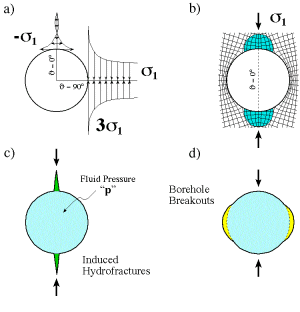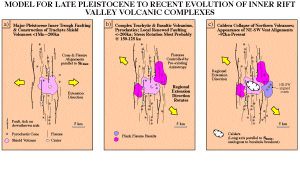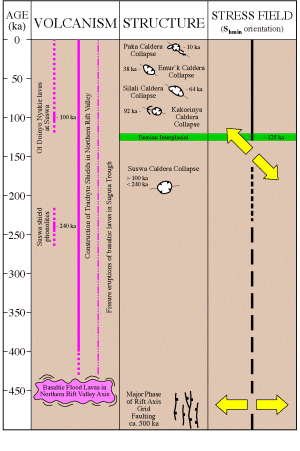Magma Chamber Elongation and Caldera Collapse Mechanisms
The state of stress in the wall rock adjacent to a magma chamber will depend upon the pressure of the magma fluid, the actual shape of the chamber, the depth below the surface and density of the overlying rock burden, fluids that may be present within fractures or pore space of the wall rock, and any applied far-field stresses. If, however, the geometry of the magma chamber can be approximated as a fluid-filled cylinder, and assuming the country rock to be elastic, isotropic and infinite, then an exact solution exists for the radial and tangential stresses around the chamber. This is a form of the circular hole problem, considered by Jaeger and Cook (1969) to be "perhaps the most important problem in rock mechanics." It is critical to understanding the stability and failure of tunnels and boreholes. In structural geology, application of the analysis of the distortion of stress fields around circular holes has been applied to problems of solution transfer and "pressure solution" in experimental (Sprunt and Nur, 1977; Bosworth, 1981) and naturally deformed (Engelder, 1982) solid-fluid systems. Failure around vertical boreholes, known as borehole breakouts, has also proven to be one of the most useful indicators of the orientation of the present-day maximum and minimum horizontal stress directions in the shallow crust. In the compilation provided by the World Stress Project (Zoback, 1992; Zoback et al., 1992), 28% of the reliable stress field indicators were from analysis of borehole breakouts.
The recognition of breakouts in wellbores was first made by Cox (1970), and documented by Babcock (1978). Bell and Gough soon interpreted the formation of borehole breakouts as a stress-related phenomenon, and the application of this concept to basin analysis and determination of in-situ stresses was quickly developed in North America (Bell and Gough, 1979, 1982; Gough and Bell, 1981, 1982; Plumb and Hickman, 1985; Zoback et al., 1985; Bell and Babcock, 1986) and Europe (Blümling et al., 1983; Brereton and Müller, 1991). Breakouts take the form of an elongation of the borehole cross-section. They are detected by the use of borehole geometry tools, including 4- and 6-arm dipmeter-calipers, and various electric and sonic formation imaging tools. In practice, breakouts must be differentiated from washouts and drill-pipe wear of the wellbore, which are not stress-induced but also cause departures from hole circularity.
The simplest circular hole case to consider is one in which uniaxial compression of magnitude s1 is applied at infinity, perpendicular to the axis of the hole in a radial direction q = 0° (Fig. 7a,b). In this case, the tangential stress around the hole will vary from 3s1, at q = 90°, to -s1 , at q = 0° (Kirsch, 1898; Hubbert and Willis, 1957; Jaeger and Cook, 1969). If a far-field stress s2 also exists in the direction q = 90°, then the tangential stresses become 3s1-s2 and 3s2-s1, at q = 90° and q = 0°, respectively. For many engineering problems, such as an air-filled vertical shaft, these solutions are appropriate. However, in geological examples, the hole is generally filled with a fluid, such as magma or drilling mud, at a pressure p. In this case the tangential stress will vary from 3s1-s2-p to 3s2-s1-p, with the radial stress at a constant value equal to p. Two modes of failure are possible under these conditions. If p>3s2-s1, then tensile stresses exist at q = 0°. If the tensile strength of the hole wall material is exceeded, then a fracture will propagate away from the hole in a direction parallel to s1 (hydraulic fracturing; Fig. 7c). In the region of q = 90°, shear stresses will be at their maximum, and the wall material can undergo compressive shear failure. Detailed ultrasonic televiewer observations in wellbores indicate that the region of failure, or "breakout" (Fig. 7d), is rather broad and flat-bottomed, producing a hole cross-section that is approximately elliptical at its advanced stages of development (Zoback et al., 1985; Hickman et al., 1985). Borehole breakouts are equally common in regions of tectonic shortening, extension and strike-slip faulting.
The initial intrusion of magma into the earth’s crust is, essentially, a large-scale hydrofracturing phenomenon (e.g., Fink and Pollard, 1983). Shallow crustal magma chambers are probably generally emplaced via large-scale dikes or dike swarms. However, many volcanoes are roughly circular in form, and they are capped by summit craters that are also commonly circular. Eroded volcanoes often reveal roughly cylindrical stocks beneath their centers. These lines of evidence suggest that after initial emplacement, the main magma chambers beneath volcanoes evolve into rather equi-axed, or nearly cylindrical bodies, probably by melting and assimilation of adjacent country rock and previously extruded volcanic material. Periodically, as new magmas are forced into an existing chamber, induced hydrofracturing of the adjoining country rock may occur, contributing to flank fissure eruptions or the formation of additional volcanic cones. Whenever the pressure in the magma chamber drops, however, it is more likely that failure of the chamber walls will occur by compressive shear fracturing adjacent to the Shmin direction. This large-scale breakout process should produce an elliptical cross-section. If the volcano collapses due to the rapid withdrawal of magma, then the resulting caldera should also be elliptical, with its long axis parallel to the regional Shmin. The calderas of Emuruangogolak and Silali have shapes very similar to those reported for borehole breakouts, and this can be attributed to the effects of the Late Pleistocene to Recent stress field that existed in the vicinity of the Kenya rift valley.
Dunkley et al. (1993) have shown that there is little evidence for the existence of older calderas in the northern Kenya rift, and that the post-92 ka calderas in the north, and the slightly older calderas in the south, are a unique feature in the evolution of the rift. This is also the situation in the Ethiopia rift valley, where large calderas are generally confined to silicic volcanoes of the very young, roughly axial Wonji fault belt (Mohr and Wood, 1976). However, large magma chambers should have been present within the axial rift valley at other times in the past. We have suggested that the onset of caldera collapse was triggered by the regional change in stress field (Bosworth et al., 1996). During the early development of the shield volcanoes (~1 Ma to ~200 ka), with Shmin oriented E-W to ENE-WSW, existing rift-parallel fractures were ideally oriented to facilitate lava movement (Fig. 8a). Suswa’s magma chamber was intruded during this time, began to deflate (hence entering into chamber wall compressive failure), and became elongate approximately N83°E. Definitively after ~500 ka, and most probably at 150-125 ka, the regional stress field began to rotate in a clockwise direction, but did not produce immediately visible effects in the volcanic structure of the rift axis (Fig. 8b). The younger (or longer-lived) northern magma chambers, however, began to elongate progressively more toward the NW-SE. The new stress field also favored the formation of NE-SW aligned extension fractures, and reactivated rift-parallel fractures and faults as dextral strike-slip faults (Strecker and Bosworth, 1991). The combination of better fracture interconnectivity plus strike-slip fault movement eventually triggered catastrophic removal of lava from beneath the northern summits, starting at Kakorinya sometime after 92 ka (Fig. 8c).
The temporal correlations between volcanism, structuring and stress field orientations are summarized in Figure 9. Kakorinya is elongate parallel to N75°W. The younger calderas at Silali (<64 ka), Emuruangogolak (<38 ka) and Paka (~10 ka) display elongation directions of N58°E to N55°E. The progressive change in caldera orientation, from Suswa to Paka, has followed, with some lag time, the counterclockwise rotation of the regional Shmin direction.


